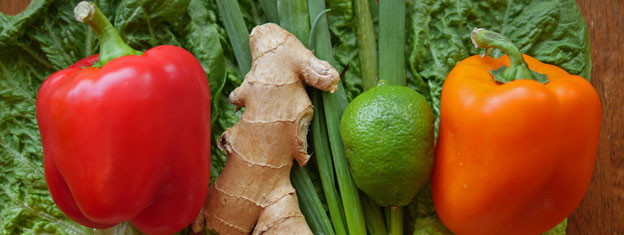Yi Jing Mei leans against the cabinets and rests before she pushes the shopping bag onto the countertop. I’m old, she thinks. The bag rustles as she digs out the day’s shopping. Fish. A clammy, squashy lump, just like me. A bag of zucchini. Too many for just me, I suppose. But she can’t pass up a good deal from the “Specials” shelf. So what if they have some spots, if they are a little nicked or a little soft? I’m going to climb up there with a 99¢ sticker on my forehead one day.
“What a bargain, right?” She laughs grimly. “Piggy, I’m home.” A shuffle and a whine and a thump come from the bedroom.
“Lazy dog.” When she turns to put the fish in the fridge, she sees the wet spot on the floor, across from the newspapers in the corner.
“Piggy, you’re going in diapers if you do that again. Do you hear me?” Another scuffle. “Can you clean that up? I’m putting the groceries away.” She digs a papaya out of the bag, another find on the ‘Specials’ shelf. Under the fluorescents of her kitchen, it looks older than in the market, a little grey fuzz in the black circles on the skin and by the stem, and soft on one side like it has lain without turning for too long.
“Don’t know why I bother. Nothing tastes right anyway.” She pushes at the soft spot with an offended finger. But if she stops eating again, Lena and Leo will start nagging her about the Home, especially if she ends up in the hospital a second time. “I guess I should cut this up before it goes bad.”
“Piggy, clean up your mess! I can’t do everything for you.” A slow scrabble of claws and a long groan.
She finds a knife and pares the peel in a thick length into the sink, then cuts the papaya in half in her hand. She plops one half into a plastic tub, then scoops the seeds out of the other half with the tip of the knife. She turns at the sound of nails on the linoleum.
“Piggy, there you are, you bad dog.” Piggy looks up at her through clouded eyes. Her hind legs take three steps in place, then her back end lowers unsteadily onto the floor. Her front paw comes up in a question mark.
“This isn’t for you. This is fruit, Greedy. You don’t want this.”
The paw question marks in the air a couple of times. Piggy says, “Hm, hm.”
“Hm, yourself. You think you know everything. Can’t even find the newspapers to pee on. Hm.” But she turns and cuts off the nub of the papaya and offers it to Piggy. “Like eating styrofoam, right? Or Leo’s dirty socks, right?” She glares at Piggy, who is about to leave another mess on the floor. But Piggy’s pink tongue laps and her jaws work, and she gulps. Her paw comes up in a question mark again.
“What? Crazy. You can’t have any more. Just throw it up.” When she turns away, Piggy sighs and lays down.
She looks at the papaya still in her hand, then at the dog. With a small shrug, she cuts off another piece, brings it to her mouth. Her lips pucker up, but then she pries them open. She shoves the papaya in before she can think better of it.
The tender flesh and earthy-sweet tang — with a touch of over-ripeness — burst on her tongue. It is the exact taste of that papaya that she had shared with Jing Li back in Siantar that year when it seemed like the rain would never stop…. Fat raindrops drummed thickly on the roof and windows that day, too, and the wind raked at the shuttered houses up and down the street. They sat with their skinny legs splayed on the cold tabletop, their bags of provisions on their outspread skirts. They could hardly hear themselves laughing as they pretended to be stranded on a desert island after a monsoon.
“Li Li, look, I have toasted melon seeds to shoot at the marauding hordes of desperadoes! And here are dry crackers for when we are starving to death, right?”
“We won’t starve,” Jing Li scoffed. “Look, Little Sister, I have a fishing pole. We won’t go hungry as long as we can fish,” she said, untying her bundle from the end of a broomstick. “And look, here’s a papaya, the only one that wasn’t blown away by the monsoon!”
“But how’re we going to open it? Oh! I know! We’re savages, and we’ll tear into it with our bare teeth, right?” Jing Mei picked it up and breathed in the grassy sweetness of it.
“No, Mei. Look!” Jing Li looked around. She flipped back a corner of the cloth to show a small paring knife.
Jing Mei put a hand over her mouth. Cook’s knife! She would never have let Li Li borrow it.
She looked around again. “Don’t worry. We’ll put it back. She won’t find out.” The browns of her eyes were ringed with white. “Oh! Pretend that she’s one of the desperadoes, and she’s coming to cut us up and put us in the soup pot!”
Jing Mei couldn’t help shrieking a little, and she huddled close to Jing Li. “Let’s eat it quick!”
Hunching over her lap, Jing Li peeled the papaya, then cut off knobs of juicy, orange flesh that they popped into our mouths. “Oh! Papaya is just the best fruit in the whole world!”
Jing Mei laughed and sputtered and nodded, cramming another piece into her full mouth.
“Keep an eye out for desperadoes!” Jing Li said as she continued cutting chunks and scraping seeds onto the table.
“You’re making a mess!” Jing Mei laughed.
“It doesn’t matter! The desperadoes will get us before Mama does,” she said, but she started scraping the seeds into her hand.
Suddenly, the wind gusted through the room, pushing Cook inside, soaked and scowling at a broken umbrella in her hand, and in the midst of a rant, “…known better than to try to go to the market on a day like this, but Mistress really had her heart set on…” There was a long silence. She looked at us on the table. With her precious knife. Papaya everywhere. Jing Li and Jing Mei looked back at her, and then Jing Mei was snorting papaya out of her mouth, but Cook’s mouth closed and set up in a thin line.
Then Jing Mei looked at Jing Li and saw that she wasn’t laughing. Her eyes were round, and she looked at Jing Mei and gulped, “Desperadoes!” Jing Li threw the papaya seeds that she had gathered in her hands. Jing Mei shrieked and threw the melon seeds. Black dots appeared on Cook’s face and hair and her soaking wet dress. “Run! Run!”
They squealed and scrabbled off the table, Cook’s knife clattered to the floor as they ran out the back way and into the rain, and Cook suddenly came back to life, screaming, “Come back, you ruffians! How dare you…”
They hid at the school yard, laughing as they took turns looking like Cook with her face pocked with melon and papaya seeds. Their bravery in the face of certain death at the hands of the desperadoes made them strong against the wind and the rain all afternoon. They kept their faces turned away from the beating that they knew was waiting for them at home….
“Oh, Piggy, we were terrible.”
Her paw comes up again.
“No, Piggy, it’s mine. Does it smell like it’s going to rain?”” She realizes that she is leaning against the cabinet again. “Let’s clean up that mess, Piggy. Lena’s coming.”




